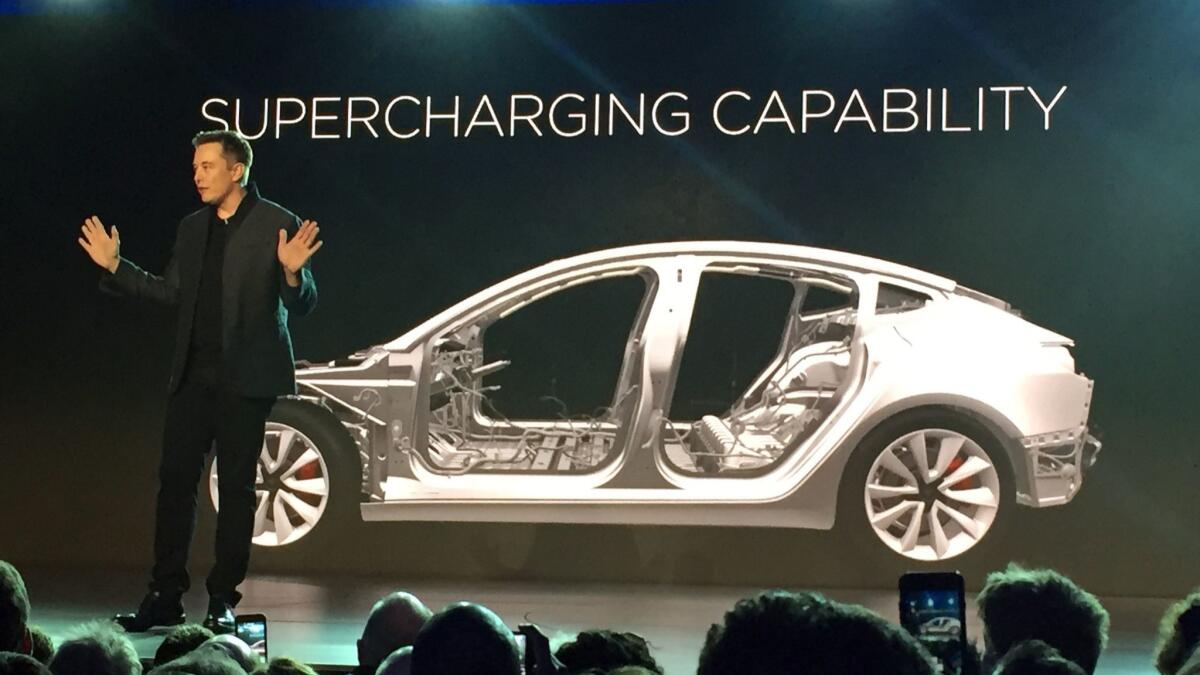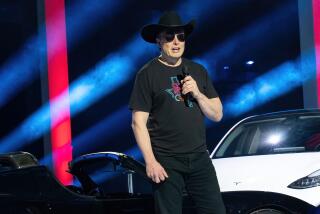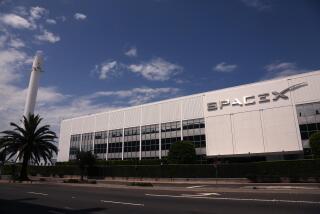Column: California fires a shot at Tesla over its labor policies

To entrepreneur Elon Musk, building Tesla electric vehicles is about creating âone of the great companies of the 21st century,â one that is âfair and just ⌠the only kind worth creating.â
To the United Auto Workers, which is trying to unionize Teslaâs Fremont factory, building Tesla cars is about doing so at substandard wages and in dangerous conditions, accompanied by efforts to suppress the unionization campaign.
Then there are California legislators and Gov. Brown, who enacted legislation earlier this month threatening to withhold rebates on electric vehicles unless their manufacturers can be certified âas being fair and responsible in the treatment of their workers.â
We want to make sure that the public investment California is making creates both cleaner air and good jobs for our economy.
— Angie Wei, California Labor Federation
That could be a considerable threat, since Tesla customers this year have been collecting almost $1 million a month from the state in rebates on the automakerâs luxury Models S and X, at a rate of $2,500 per car. The claims are certain to rise in coming years as Tesla ramps up production of its mass-market Model 3, which just began coming off the assembly line.
The new law has stirred editorialists across the state, who have come down heavily on Teslaâs side. âOutrageous groveling to unions,â groused the San Jose Mercury; âa thinly veiled threat against an employer of thousands of Californiansâ was the description offered by the San Francisco Chronicle. (These clips were brought to my attention by Tesla, as an indication of its opinion of the legislation.) The Times editorial board hasnât spoken on the issue.
The legislation applies not only to Tesla, which is aiming to mass-manufacture cars in California, but to all automakers whose vehicles are eligible for state rebates. That includes Nissan, Toyota, GM, Ford, BMW and lesser-known companies such as Bluecar and BYD.
The rebate program has been a boon for the electric carmakers, whose customers have collected nearly $449 million in state rebates since the program began in March 2010. About $140 million has been appropriated in the current fiscal year for the rebates, which are entirely funded from cap-and-trade program revenues; an allocation for the next fiscal year hasnât yet been made. Significantly fewer rebates have been doled out his year â $60.3 million through Sept. 28, compared with $71 million in the same period in 2016 â but thatâs mostly because the state imposed income limits in mid-2016 so the rebates wouldnât go strictly to wealthy buyers. That may have hurt Tesla, a luxury brand that accounted for more than 21% of all rebate dollars last year, but only about 12.4% so far in 2017.
Still, it appears that the stateâs shot was aimed chiefly at Tesla. The language was inspired by the California Labor Federation, which is affiliated with the UAW, which in turn is engaged in a ferocious unionization battle with Musk and Tesla.
âThe big picture for us is that the auto manufacturing industry created at least two generations of middle-class families,â Angie Wei, chief of staff of the labor federation, told me. âNow, not only are we replacing combustion-engine cars, but weâre incentivizing it with public money. The question is whether thatâs going to duplicate the middle-class life that was created for so many families.â
The unions say that wonât happen at the wage rates and working conditions typical in the electric vehicle industry. Teslaâs own figures put average annual hourly pay for Fremont workers who started in January 2013 at about $39,000, or a bit less than $19 an hour. âNo one can survive in California on that,â says Wei, âespecially in the Bay Area.â The corresponding hourly wage at General Motors, by Teslaâs reckoning, is nearly $24.
Musk acknowledged in an email to Tesla employees that cash compensation at Tesla, healthcare and other benefits have run well behind those of GM, Ford and Fiat Chrysler. He argued that the difference was more than balanced by Tesla workersâ access to stock grants. By their nature, however, the value of those grants is conditional â as J.P. Morgan once said, stocks âfluctuate.â Unless Tesla is guaranteeing its sharesâ value to employees, stock grants arenât the equivalent of hourly cash pay. Itâs true that over the last four years, the shares have gained nearly 90%, but there have been periods in that span when theyâve taken a tumble, too.
Workers who moved to Tesla from NUMMI, the joint Toyota-GM automaker that built the Fremont plant before shutting down in 2010, may feel the pinch especially acutely. Tesla production worker Hai Nguyen, 38, says he earned $32 an hour at NUMMI, where he worked for nine years. Now he collects $18 an hour at Tesla, where heâs been employed for just over four and a half years performing roughly similar work. He says he received options on 60 shares of Tesla stock when he joined, but had to sell them to make ends meet when they vested four years later. Subsequent option bonuses, he says, are at the discretion of supervisors. Nguyen is involved in the UAW organizing campaign.
Tesla has mounted an aggressive anti-labor campaign that has resulted in a formal accusation of unfair labor practices lodged in August by the National Labor Relations Board. A hearing is scheduled to begin in Oakland on Nov. 14. Among the allegations is that Tesla supervisors and security guards have improperly interfered with union leafletting.
The NLRB also indicated it regards the confidentiality agreement employees are required to sign as overly restrictive. The agreement states that âeverything you work on, learn about or observe in your work about Tesla is confidential,â including information about other employees, and warns that âit is never OK to communicate with the media or someone closely related to te media about Teslaâ without permission. The board has regarded some such agreements as violations of federal labor law, and itâs prevailed in federal court. Tesla called the NLRB filing âbaselessâ and âentirely without merit.â
Muskâs own comments about the union drive also have a retrograde tone, not unlike what one might hear from an industrial magnate in the 1890s. Following a post on Medium.com about injuries and poor pay by Tesla worker Jose Moran, Musk accused Moran of being a paid union agitator and painted the UAW as an organization that âdoes not share our mission and whose true allegiance is to the giant car companies, where the money they take from employees in dues is vastly more than they could ever make from Tesla.â The company says itâs working to make Fremont âthe safest car factory in the worldâ and that its safety record is âmuch better than [the] industry average.â
Some workers question that. Nguyen says the safety culture at Tesla doesnât match NUMMIâs, where he says equipment was better maintained and work routines more standardized. âThey donât take safety as seriously as they say they do,â he told me. Workers often are loath to complain, because âthereâs no job security.â
That brings us back to the stateâs initiative on electric vehicle manufacturersâ labor relations. Itâs unclear how much Tesla or any other companies have to fear from the legislation, which Gov. Brown signed on Sept. 16. The measure expresses the legislatureâs âintentâ that the Secretary of Labor work with the Air Resources Board to âdevelop proceduresâ to certify the automakers as âfair and responsibleâ in time for the 2018-2019 rebate year. Labor Secretary David Lanier will start working on that process with âstakeholdersâ â including organized labor and the manufacturers â in coming months, according to his spokesman. Prospective buyers, who are the direct beneficiaries of the rebates, also can be expected to weigh in.
The process, in other words, is wide open. âWeâre all trying to figure out how this will play out,â says Chuck Colgan, a spokesman for the Center for Sustainable Energy, a nonprofit that runs the rebate program for the state.
The factors likely to be used to judge a companyâs employee relations are easy to guess, if not the weight theyâll carry. Unresolved NLRB suits or a surfeit of OSHA complaints: bad. Competitive wage rates: good. The rules worked out by the Labor secretary and ARB will probably have to be approved by the legislature, so the industryâs lobbying clout also will be stirred into the cauldron.
But encouraging good labor relations hasnât always been easy for government agencies, especially in recent years when corporate profits have soared and wages have stagnated. Critics of the âfair and responsibleâ rule should explain why itâs wrong for California to hold manufacturers using millions of dollars in public funds to pump up their sales to broad standards of behavior. âWe want to make sure,â Wei says, âthat the public investment California is making creates both cleaner air and good jobs for our economy.â
Keep up to date with Michael Hiltzik. Follow @hiltzikm on Twitter, see his Facebook page, or email [email protected].
Return to Michael Hiltzikâs blog.







